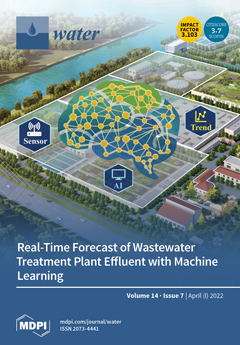Financial feasibility is usually a concern in water reclamation projects. Aside from internal benefits, water reclamation in industrial parks delivers health and environmental benefits not normally considered in cost–benefit analyses (CBA). This study investigated the influence of environmental benefits on the feasibility of
[...] Read more.
Financial feasibility is usually a concern in water reclamation projects. Aside from internal benefits, water reclamation in industrial parks delivers health and environmental benefits not normally considered in cost–benefit analyses (CBA). This study investigated the influence of environmental benefits on the feasibility of water reclamation projects with flow rate scenarios in accordance with industrial parks in Chonburi, Thailand. CBAs of water reclamation plants for industrial water supply, consisting of ultrafiltration (UF) and reverse osmosis (RO), with flow rates of 5200, 10,000, 15,000, and 25,000 m
3/day and discount rates of 3%, 5%, 7%, 9% and 11% were conducted. Considering only the direct costs and benefits, none of the projects were financially feasible. However, when the environmental benefits were included, the projects became profitable in all cases except those with a flow rate of 5200 m
3/day and discount rates of 5%, 7%, 9%, and 11% and those with flow rates of 10,000 and 25,000 m
3/day and an 11% discount rate. Further, CBAs of water reclamation projects in industrial parks for irrigation were conducted with post-treatment processes consisting of sand filtration and chlorine disinfection for flow rates of 240, 480, 2400, 3600, and 4800 m
3/day. The projects are profitable, regardless of environmental benefits.
Full article





